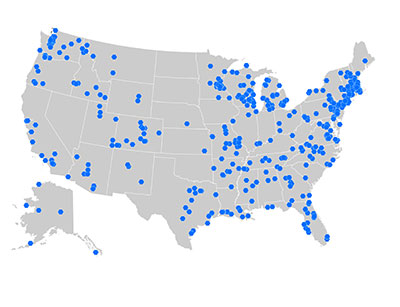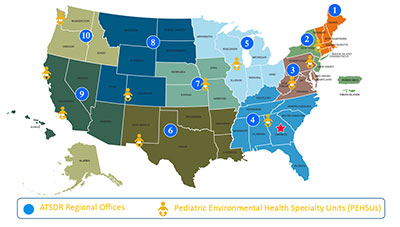Agency for Toxic Substances and Disease Registry
MISSION
To investigate environmental exposures to hazardous substances in communities and take action to reduce harmful exposures and their
health consequences.
ORGANIZATION
- Division of Community Health Investigations
- Division of Toxicology and Human Health Sciences
PRIORITIES
- Reduce the health impact from exposures to harmful chemicals in communities.
- Protect vulnerable populations (such as children, pregnant women, and the elderly) from the health risks of harmful exposures.
- Advance environmental science and medicine.
Why We’re Here
The Comprehensive Environmental Response, Compensation, and Liability Act of 1980-a.k.a., the “Superfund” Act-created the Agency for Toxic Substances and Disease Registry (ATSDR) to serve as a science-based public health agency working to address community concerns about hazardous waste. For 3 decades, ATSDR has kept people in more than 6,000 U.S. communities safe from environmental hazards.
Printable Version [PDF – 401 KB]
- ATSDR protects Americans’ health by preventing exposure to harmful contaminants in our soil, water, and air.
- ATSDR responds to requests from communities across the country to protect people from exposures to harmful levels of substances in the environment.
- ATSDR provides funds to state health departments and supports environmental health professionals in regional and field offices. Along with Atlanta-based headquarters staff, ATSDR experts are ready 24/7 to respond to environmental health threats from natural disasters, chemical spills, and other emergencies.

Communities Where ATSDR Assessed Exposures and Human Health During FY 2013–2016
How We Work
- Work in communities to assess human exposures to potentially harmful contaminants and their impact on health.
- Provide expertise to communities so they can take action to protect health.
- Respond to questions about environmental exposures and provide guidance to healthcare providers.
What’s Needed
- Close the gap between communities’ needs to protect themselves from harmful environmental exposures and ATSDR’s current capacity to respond, provide assistance, and prevent harmful health effects.
- Increase understanding about the health effects of toxic exposures and how biomonitoring activities can lead to health improvement.
- Expand the use of technological tools and new methods to increase effectiveness and timeliness in protecting communities from environmental hazards.
- Increase knowledge about how the combination of chemicals at hazardous waste sites affect human health and the ways in which toxic exposures affect vulnerable populations such as pregnant women and young children.
- Increase dissemination of the ToxProfiles and other toxicological analyses to provide data for public health action.

Long-Term Opportunities
- Expand ATSDR’s capacity to be able to respond to a greater number of requests and petitions for investigations of harmful exposures in communities and recommend actions to protect health.
- Expand the APPLETREE cooperative agreement to all 50 states and increase awards to enable each state to promote and implement child care safe-siting initiatives to protect children from health risks caused by placing child care and early learning facilities in hazardous locations.
- Expand current state cooperative agreements program to assess and safely redevelop brownfields and land reuse sites to improve economic value in communities.
- Improve opportunities to support investigations of adverse health effects in rural populations.
- Continue the Navajo Birth Cohort Study to investigate possible neonatal health effects caused by uranium exposure from past mining and milling operations in the Navajo Nation.
For more information visit https://www.cdc.gov/nceh or call 1-800-CDC-INFO.
Assessed more than 900,000 people in FY 2016 who were potentially at risk of harmful exposures to chemicals through over 130 health consultations and assessments.
Provided on-the-ground, local support to communities through the work of 400 environmental health professionals located in regional offices, state public health departments, and pediatric environmental health specialty units.
Assisted the Michigan Department of Health and Human Services with investigating reports of new or worsening skin rashes in people exposed to Flint municipal water; collected and analyzed water samples from 170 homes, conducted interviews, and made recommendations for public health interventions.
Released 12 new ToxProfiles in FY 2016 that were used to guide public health decision-making by helping assess health effects, identify exposure routes and environmental sources of concern, and determine which chemicals and exposures posed public health risks.
Developed guidelines, tools, and resources to help ensure child care centers are located where chemical hazards have been considered,
addressed, and mitigated to best protect children’s health.
Reduced Amyotrophic Lateral Sclerosis (ALS) disease burden by improving identification of incidence, prevalence, and risk factors; conducting research; and launching the National ALS Biorepository to provide thousands of samples for research.